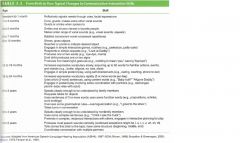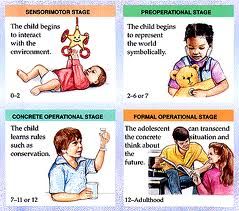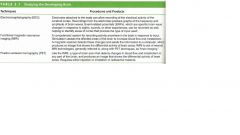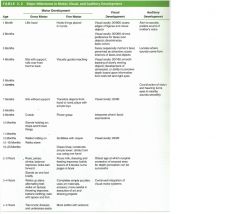![]()
![]()
![]()
Use LEFT and RIGHT arrow keys to navigate between flashcards;
Use UP and DOWN arrow keys to flip the card;
H to show hint;
A reads text to speech;
40 Cards in this Set
- Front
- Back
- 3rd side (hint)
|
Functions of Emotions
Survival: |
Fear, sex, disgust, affection, conscience
|
|
|
|
Functions of Emotions
Communication: |
- verbal and nonverbal
- social significance including attachment |
|
|
|
Functions of Emotions
Cognitive Functioning: |
Phineas Gage matrix: a syndrome consisting of cognitive dysfunction such as poor planning, inadequate decision making, inability to take another's perspective, and problems sustaining employment. These go hand in hand with emotional problems such as shallow affect, lack of passion, and dimished sense of pleasure or pain. Therefore, absence of emotion in intellectual functioning leaves us lacking resourcefulness
|
|
|
|
Functions of Emotions
Mental health and wellness: |
emotional intelligence
|
|
|
|
Innate Emotional States
|
- Certain emotions are inborn and universal
- some emotions are interpreted the same across all cultures - Infant facial expressions - physiologically there are subcortical structures that mediate particular emotions |
|
|
|
Emotional Development
General: |
- Range of expression increases dramatically in first two years of life
- birth includes crying, smiling, avoidance, and staring - 2-6 months anger surprise, fear, and sadness emerge - 2nd year of life come social emotions like pride, shame, embarassment, and guilt |
|
|
|
Izard's Differential Emotions Theory
|
Emotions are a direct product of the underlying neural processes related to each of the emotional expressions
|
|
|
|
Sroufe's Developmental Position
|
- Early infant emotional expressions are considered precursors of more mature emotions
- Infants lack cognitive ability needed to ascribe meaning to emotional experiences |
|
|
|
Early Caregiver-Infant Interactions & Emotional Development
|
- Infant behaviors elicit care and positive attention
- 5 weeks: social smile (usually with mom) - 3 months:turn taking can be observed - creation of social and communicative bond between infant and caregiver ensures safety, food, and shelter - supportive, responsive caregiving is the key to development of infant's emotional heath and regulation |
|
|
|
Emotional Regulation
|
= strategies and behaviors we use to moderate our emotional experiences in order to meet the demands of different situations or to achieve our goals
- newborns have poor emotional regulation - Social referencing: visual cliff experiment - inborn coping strategies: seek other or resort to self directed,(think still face paradigm with mom), also interactive repair - Crucial in emotional well-being and positive adjustment throughout lifespan |
|
|
|
Interaction of Infants with depressed mothers
|
- At-risk: synchrony between infant and caregiver is interrupted
- interactions often go unrepaired |
|
|
|
Depressed Caregivers
|
show less positive affect, looke away more, show anger, and have poorly timed responses
|
|
|
|
Infants of depressed mothers
|
-have increased levels of negative emotional states and self-directed coping in infants
- coping is marked by escaping and turning away - by 4 mos infants are less active in face to face interactions with mom - by 5 mos less laughing and more fussy - future social and cognitive development can be affected |
|
|
|
Attachment
Early social relationships: |
Bowlby, Erikson - Relationships with caregivers in 1st year of life play an important role in determining how secure and optimistic a child will later feel about exploring the world
- early relationships lay the groundwork for future interactions with others, child's self-concept, and outlook on life. |
|
|
|
Attachment
Early social relationships cont.: |
Basic Trust - seeing others as dependable and trustworthy influences how we see ourselves
Attachment theory- infant and caregivers participate in an attachment system that exists to keep the infant safe and ensure his/her survival - Separation anxiety, stranger anxiety, proximity maintenance, secure base, safe haven - Working models - prototypes of social functioning that affect the child's expectations and behavior in future relationships |
|
|
|
Attachment Quality & Strange Situation Test
|
-Developed by Mary Ainsworth and colleagues
- Three patterns of infant response: Securely attached Insecurely attached - anxious ambivalent Insecurely attached - avoidant -Main and Soloman added fourth pattern of "Insecurely attached- disorganized/disoriented |
|
|
|
Mothers of securely attached infants
|
Respond promptly and consistently to crying, handle infant with sensitivity, hold baby tenderly and often, and face to face interactions are responsive to baby's signals
|
|
|
|
Mothers of ambivalent infants
|
Are affectionate but awkward in holding, show inconsistent responsiveness to crying, and fail to respond to baby's signals
|
|
|
|
Mothers of avoidant infants
|
Actively avoid holding babies, are rejecting and angry, and show less warmth and affection
|
|
|
|
Mothers of disorganized/disoriented infants
|
Frightening and/or abusive parental behavior
|
|
|
|
Additional influences on mother infant relationship quality
|
Infant temperament: infant traits
examples: fearfulness reactivity irritability activity level positive affect attention-persistence |
|
|
|
Infant Temperament Traits
|
- some traits are correlated with physiological variations
- High reactive infants - produce vigorous limb activity, high levels of muscle tensions, and react irritably to sensory stimulation - Low reactive infants - unusually low on the same measures -Early reactivity leads to behavioral inhibition or shyness |
|
|
|
How is infant temperament related to parents' caregiving?
|
Difficult babies- (about 10%) more fearful, irritable, active, less positive affect, more irregular
Easy babies - (about 40%) more placid, less active, more positive, more regular in their rhythms Slow to warm up babies - (about 15%) like easy babies in many ways, but like difficult babies in their fearfulness, showing more wariness in new situations than most babies Mixed or variable (about 35%) - did not fit well into any of the more extreme groups Conclusion: temperament can affect parenting, and parenting can moderate temperament |
|
|
|
Role of temperament in developing attachment relationships
|
- goodness of fit model
- inverse relationship between proneness to distress and mother's warmth, support, and positive emotional tone - suggested that maternal caregiving predicts whether infants will be securely or insecurely attached - caregiving plays a causal role in attachment security, especially for more difficult tempered children |
|
|
|
Class and Culture impacting attachment
|
- Caregiving environment can be impacted by inadequate housing, education and income
- life stressors have an impact - discord and violence in the home can independently affect attachment - Relationship between caregiver sensitivity and attachment security is consistent across cultures, but definition of sensitive care may vary by culture |
|
|
|
Variations in attachment relationships
|
-attachment quality is usually uniform across caregivers depending on quality of each relationship and possible generalization to other caregivers
|
|
|
|
Stability and change of attachment relationships
|
-Attachment status can change over time
- secure attachments are less likely to change - children from low SES groups are more likely to shift status - the longer an attachment status is in place, the more entrenched it is likely to become |
|
|
|
Early attachment quality as a predictor of later psychosocial functioning
|
Secure: more likely seen as direct and appropriate in relationships, more friends and more confident
-Best outcome if securely attached to both parents - Later parenting can also affect the outcomes |
|
|
|
Working models of attachment
|
-Infant attachments influence the internal working model of relationships that children begin to construct
- provides a template for adult social relationships - parents' working models of attachment may influence their infant caregiving, thereby affecting babies' attachment security |
|
|
|
Multidimensional Model of Intergenerational Transmission
|
-Effects of context and later experience on the attachment classification of an infant
- parent's early attachment experiences are modified by later attachment relationships and current social context (ie supportive partner) - child's temperament influences attachment - disruptive experiences in child's life (death of parent, illness, abuse) can result in discontinuity of attachment -Importance of early intervention and prevention |
|
|
|
Role of Therapist in Infant Mental Health
|
- Provide a voice for the baby
- Provide support for the parent - Help them to learn new skills |
|
|
|
Developmental Progressions
|
a. Age-Graded Changes
b. History-Graded Changes c. Nonnormative Changes |
a. universal and specific
b. shared and cohort c. specific and individual |
|
|
Qualitative Vs Quantitative Developmental Change
|
1.Qualitative:“transformational” Increasing in complexity dev has directionality. (Sudden changes may be the manifestation of small incremental changes)
2. Quantitative: “incremental”, “ growth” a.Alternation in existing behavior, but does not involve substantial or wide-ranging reorganization |
|
|
|
Mechanistic View of Development
|
Development is akin to chainlike sequence of events
a. Development primarily shaped by external forces b.Person has limited control |
|
|
|
Organismic Theories of Development
|
People are active initiators of their own development. People are not easily coerced by outside agent.
|
|
|
|
Bidirectionality Development
|
Organism and environment change one another
|
|
|
|
Birth to Five Typical Changes in Communication/Interactive Skills
|

|
|
|
|
Piaget's Stages of Development
Stage name, ability and age |

|
|
|
|
Methods for Studying the Developing Brain
|

|
|
|
|
Chronological Milestones of Development
|

|
|

